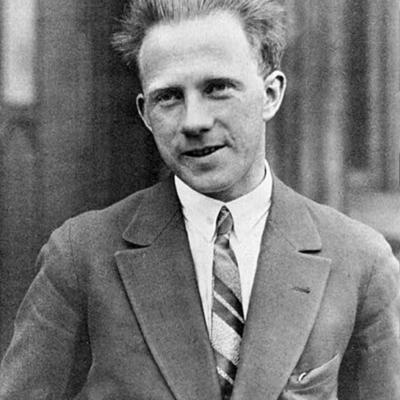Anúncios
Werner Heisenberg, one of the greatest physicists of the 20th century, revolutionized quantum mechanics with the formulation of the Uncertainty Principle. This principle challenges the classical view that it is possible to simultaneously measure, with absolute precision, multiple properties of a particle. Heisenberg’s discovery brought forth a new understanding of the limits of measurement in subatomic physics, forever changing science.
The Uncertainty Principle of Heisenberg is not just a mathematical theory; it altered the perception of reality and introduced a new way of thinking about the quantum world. By understanding that certain pairs of physical properties are, by their nature, incompatible, Heisenberg paved the way for new research and technologies, influencing areas such as quantum computing and cryptography. The impact of this discovery continues to resonate in the development of modern physics.
Anúncios

The Essence of Heisenberg’s Uncertainty Principle
Heisenberg’s Uncertainty Principle states that it is impossible to precisely determine the position and momentum of a particle simultaneously. The relationship between these two properties is inversely proportional, meaning the more precisely we try to measure one, the more imprecise the other becomes. This limitation is not due to experimental flaws but is a fundamental characteristic of the behavior of subatomic particles.
At a deeper level, uncertainty is not just a technical flaw but a manifestation of quantum properties. The act of observing or measuring a particle alters its state, leading to the impossibility of knowing its behavior in all aspects. This idea was a break from classical physics, where it was believed that measurement did not affect the system.
The mathematical equation that describes this principle is expressed as ΔxΔp ≥ ħ/2, where Δx represents the uncertainty in position and Δp represents the uncertainty in momentum. The reduced Planck constant (ħ) is fundamental to this expression and reflects the fundamental nature of quantum mechanics. The equation highlights that there is a fundamental limitation to the precision of measurements in quantum systems.
When studying the behavior of subatomic particles, the Uncertainty Principle shows that we cannot simply apply classical physics laws. The quantum nature of systems requires a new approach, one that recognizes the unpredictability and limitations of measurement. This shift in perspective is essential for understanding quantum mechanics.
Applications of the Uncertainty Principle in Quantum Physics
Understanding the Uncertainty Principle has several important applications in quantum physics. It allows scientists to better understand the limitations in measuring subatomic properties, helping to formulate more accurate theories about particle behavior. The principle is also central to the development of new technologies, such as quantum computing and quantum cryptography.
In the field of quantum optics, for example, the uncertainty in position and momentum is a fundamental consideration for creating high-precision measurement devices. Instruments such as electron microscopes and spectrometers must take into account the limitations imposed by the Uncertainty Principle to obtain more reliable results. Quantum technology is, therefore, deeply influenced by these ideas.
Modern quantum mechanics uses the Uncertainty Principle to develop new experimental methods. By understanding the relationship between position and momentum, researchers can design more effective experiments and interpret experimental data more accurately. This results in significant advancements in areas such as particle physics and quantum field theory.
Furthermore, the principle is a starting point for exploring the complexities of wave-particle duality. In experiments investigating this duality, physicists must consider how uncertainty in measurements affects the results. The Uncertainty Principle, therefore, is not just a limitation but also an essential tool for exploring the fundamental nature of matter.
How Heisenberg’s Uncertainty Principle Works

Heisenberg’s Uncertainty Principle is a fundamental concept in quantum mechanics that articulates the limitations of measuring certain pairs of physical properties of a particle simultaneously. This principle, formulated by German physicist Werner Heisenberg in 1927, postulates that the more precisely we know one property, such as position, the less precisely we can know the other property, such as momentum. This intrinsic limitation is not due to experimental imperfections but is a fundamental characteristic of nature. The principle challenges classical mechanics, where it is assumed that both position and momentum can be measured with arbitrary precision.
At the core of the uncertainty principle is the wave-particle duality of subatomic particles. According to quantum mechanics, particles like electrons exhibit both wave and particle properties. When we try to measure the position of a particle, we are essentially collapsing its wave function, which describes the probabilities of finding the particle in various locations. This collapse introduces uncertainty in the particle’s momentum, leading to the conclusion that both properties cannot be known with absolute precision at the same time. Heisenberg’s Uncertainty Principle can be mathematically expressed as ΔxΔp ≥ ħ/2, where Δx represents the uncertainty in position, Δp represents the uncertainty in momentum, and ħ (h-bar) is the reduced Planck constant.
The implications of Heisenberg’s Uncertainty Principle go beyond mere measurements; they challenge our understanding of reality. In a quantum world, particles do not have definite states until observed. This leads to philosophical questions about determinism and the nature of reality. The principle also plays a critical role in the development of quantum field theory and has far-reaching consequences in various fields, including chemistry, materials science, and even cosmology, where it influences our understanding of the early universe and black holes.
In summary, Heisenberg’s Uncertainty Principle is not just a technical rule of quantum mechanics; it is a profound insight into the nature of reality. It reveals the limits of our knowledge and the inherent unpredictability of the quantum world. Understanding this principle is essential for anyone venturing into the realms of quantum physics, as it serves as a gateway to more complex concepts and theories that define modern physics.
Applying Heisenberg’s Uncertainty Principle in Quantum Mechanics

Heisenberg’s Uncertainty Principle is not just a theoretical construct; it has practical applications in various fields of quantum mechanics. Understanding how to apply this principle can enhance our understanding of quantum phenomena and lead to innovative advances in technology and research. Here are several key areas where the uncertainty principle is applied:
Understanding the Measurement Problem:
The measurement problem in quantum mechanics arises from the need to reconcile the probabilistic nature of the wave function with the definite outcomes observed during measurements. Heisenberg’s Uncertainty Principle plays a crucial role in this context, emphasizing that the act of measuring affects the system being measured. By recognizing this relationship, physicists can develop more robust interpretations of quantum mechanics, such as the Copenhagen interpretation or the many-worlds interpretation.
Exploring Wave-Particle Duality:
The uncertainty principle is closely tied to the concept of wave-particle duality, which describes how particles exhibit both wave-like and particle-like behaviors. By applying the uncertainty principle, researchers can better understand how these dual characteristics manifest in different experimental setups. This understanding is essential for designing experiments that probe the limits of quantum behavior, leading to a deeper understanding of the fundamental nature of matter and energy.
Analyzing Position-Momentum Uncertainty:
The uncertainty principle quantifies the relationship between the uncertainties in position and momentum, allowing physicists to analyze the trade-offs involved in measuring these properties. By applying this principle, researchers can optimize experimental designs to achieve desired levels of precision, taking into account the inherent limitations imposed by the uncertainty principle. This analysis is particularly valuable in fields like quantum optics and atomic physics, where precise measurements are critical.
Recognizing the Observer Effect:
The observer effect refers to the phenomenon where the act of observing a quantum system alters its state. Heisenberg’s Uncertainty Principle highlights the importance of this effect, emphasizing the limitations of our ability to measure and predict quantum systems. By acknowledging the observer effect, researchers can develop experimental protocols that minimize its impact, leading to more accurate and reliable results in quantum experiments.
Utilizing Quantum Superposition:
Quantum superposition is the principle that a quantum system can exist in multiple states simultaneously until measured. Heisenberg’s Uncertainty Principle provides a framework for understanding the implications of superposition on measurement outcomes. By applying this principle, physicists can explore the potential of superposition in quantum computing and quantum information processing, paving the way for revolutionary technological advancements.
Implementing Heisenberg’s Matrix Mechanics:
Heisenberg’s matrix mechanics is a formulation of quantum mechanics that emphasizes the role of observable quantities and their interactions. The uncertainty principle is embedded in this framework, allowing physicists to analyze quantum systems in a more abstract and mathematically rigorous way. By using matrix mechanics, researchers can gain insights into complex quantum phenomena and develop new theoretical models that expand our understanding of the quantum world.
In conclusion, applying Heisenberg’s Uncertainty Principle in quantum mechanics is essential for advancing our understanding of the quantum realm. By exploring its implications in measurement, wave-particle duality, position-momentum uncertainty, the observer effect, quantum superposition, and matrix mechanics, researchers can enhance their understanding of quantum phenomena and contribute to the ongoing evolution of quantum physics.
Did You Enjoy Learning About Werner Heisenberg and the Uncertainty Principle?
Learning about Werner Heisenberg and the Uncertainty Principle offers a fascinating glimpse into the complexities of quantum physics. The principles outlined by Heisenberg reshaped our understanding of the universe, revealing the inherent limitations of measurement and the unpredictable nature of quantum systems. This knowledge not only enriches our understanding of physics but also sparks curiosity about the mysteries yet to come.
As you delve deeper into the world of quantum mechanics, Heisenberg’s Uncertainty Principle will serve as a fundamental concept that guides your exploration of advanced theories and applications. Whether you’re a student, researcher, or simply a curious mind, the insights gained from understanding this principle will undoubtedly ignite your interest in the ongoing journey of discovery in the realm of quantum physics.
Frequently Asked Questions
What is Heisenberg’s Uncertainty Principle?
The principle states that we cannot measure both the position and the velocity of a particle simultaneously with precision.
How did Werner Heisenberg change quantum physics?
He showed that quantum physics is not as simple as previously thought. His ideas changed the way we understand the subatomic world.
Why is the uncertainty principle important?
It helps explain strange phenomena in the quantum world. Without it, many areas of modern science would not exist.
What happens if we try to measure a particle?
When you measure a particle, you alter its state. This means we can’t know everything at the same time.
What are some applications of Heisenberg’s principle?
It is used in technologies such as electron microscopes and quantum computing. This makes science more advanced and innovative.
